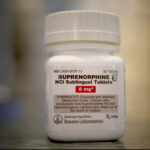It’s Time to Bring Supervised Injection Sites Above Ground
In 1986, at a community HIV prevention meeting in New Haven, Connecticut, an injection drug user spontaneously brought a bundle of clean syringes to freely hand out. By this time, the correlation between injection drug use and HIV had been made. This gave Jon Parker, a former injection drug user hosting the meeting, an idea.

Parker knew that community programs that distributed clean syringes in Europe had been having success at preventing HIV transmission. But in the U.S., the notion of giving drug users sterile instruments to inject their drugs was met with resistance by both high-ranking government officials as well as local community leaders. From their perspective, supporting what became known as needle or syringe exchange programs also meant supporting — or even encouraging — injection drug use. Government funds couldn’t go near such heresy, despite evidence showing that such programs do not increase drug use.
Fed up with watching members of their community wither away from a preventable illness, Parker, along with other activists and injection drug users, went rogue by starting one of the first underground syringe exchange programs on U.S. soil. They refused to wait idly while local public health departments hammered out the law and politics. There was no time to waste.
The same brave work is being done today. Only instead of distributing clean syringes, which is status quo in most major cities now, public health workers and harm reductionists in an unnamed U.S. city are operating an illegal, unsanctioned supervised injection site: a space where injection drug users can safely inject their drugs under the watch of medical professionals. Even under its unsanctioned status, the site is showing public health benefits, according to a qualitative study published in late December in the International Journal of Drug Policy.
It’s time to bring this site, and possibly other secret sites on U.S. soil, above ground.
In 2016, over 60,000 people in the U.S. died from drug overdoses, according to the Centers for Disease Control and Prevention. For context, that’s more people dead than during the peak of the AIDS epidemic in 2005. Having reported on the overdose crisis for years, I fear these deaths aren’t being comprehended. These aren’t just numbers from a government report. Just two weeks ago in Chicago, my friend Mike, a 27-year-old getting his master’s in social work at the University of Chicago, died from an overdose. He’ll be counted as one among tens of thousands who died in 2017, which is expected to surpass the death rate from 2016.
What if Mike wasn’t alone? What if he had a space to safely use? A space where he wasn’t judged and shamed; a space where he could talk about why, after years of recovery, he went back to the needle?
The opioid crisis is indeed the AIDS epidemic of our time. People from all walks of life are dying preventable deaths — more than 100 every day — at the peak of their lives. And yet, just as with the AIDS epidemic, the government has been slow to implement public health policies that could save these lives. And as with syringe exchange programs, government officials and community members fear that supervised injection sites will encourage people to use drugs. This is despite dozens of empirical evaluations of over 100 supervised injections sites across 10 European countries showing that these spaces save lives, reduce public injection, and function as a gateway to other vital services, including addiction treatment.
People opposed to supervised injection sites will often argue that Europe and America are too different, and that such studies are not relevant. But this is precisely what makes the work of Peter Davidson, Andrea Lopez, and Alex Kral — veteran harm reduction researchers — all the more novel. Since 2014, they’ve been collecting survey data from users of an unsanctioned injection site in the United States, and they’re finding similar results as studies in Europe.
“One of the things that came out of these interviews over and over again was the enormous relief of not having to shoot up in public, possibly in front of kids,” said Davidson, who is the lead author of the new qualitative study — the second of two studies on the unsanctioned site.
“Everyone was enormously grateful that this place existed,” he added, “and there was a fairly strong sense of protecting this place and the people who are sticking their necks out providing it.”
Interviewees also discussed relief from what’s called the “micro-risk environment,” Davidson told me. That means “being able to do the things you need to do in a clean, well-lit space where you’re not rushed makes a massive difference,” he said. “Lots of bad things happen when people are rushing shots, it can lead to soft tissue infections, which are fairly expensive to treat. So the financial impact is in everyone’s interest.”
That’s also what Sarah Mars, qualitative project director for a longitudinal National Institutes of Health/National Institute on Drug Abuse study called Heroin in Transition (HIT), said about supervised injection sites. She called them a “win-win for all members of the community.”
Along with Dr. Daniel Ciccarone, principal investigator on HIT, Mars and her colleagues study the heroin market in various urban hotspots. “Our research among injecting heroin users on the East Coast has shown an intense awareness of overdose as an imminent threat due to the highly unstable adulterated supply,” Mars said. Supervised injection sites, she added, “offer some protection from these risks.”
The number one driver of overdose deaths in America isn’t prescription painkillers or even heroin; it’s illicitly manufactured fentanyl, a super-potent opioid several times stronger than heroin. Ciccarone has told me that we’re no longer in the midst of an “opioid epidemic,” so much as what he calls a “poisoning crisis.” The heroin supply is more dangerous than it’s ever been, which makes the need for safe injecting spaces all the more urgent.
There are glimmers of hope. Harm reduction activists in cities across the United States are fighting hard for supervised injection sites in their communities. “We’re feeling very optimistic about our progress in Denver,” said Kat Humphries, director of programs and data evaluation at the Harm Reduction Action Center. Located across the street from Colorado’s State Capitol building, Humphries and her colleagues distribute needles, naloxone, and other vital, lifesaving services to injection drug users in Denver. They’re trying to turn a storage room at their facility into Colorado’s first supervised injection site. Other cities, including Seattle and San Francisco, along with the state of Vermont, are in various stages of the legislative process for a sanctioned supervised injection site.
“Most encouraging has been the outpouring of support from local businesses and organizations,” Humphries said, “who are taking a stand to provide people who use drugs a safe space to use and to prevent further public injection in their bathrooms and in other spaces like alleyways and parks.”
Despite conservative opposition, there are hundreds of syringe exchange programs legally operating nationwide. These programs exist because activists used data and told human stories showing their benefits. The fight for supervised injection spaces can be won using these tactics.
While morally entangled American policymakers debate the politics of saving human lives, rogue activists and researchers are busy saving them anyway.
Zachary Siegel is a freelance journalist covering public health and criminal justice. He is currently a Guggenheim Justice Reporting Fellow at John Jay College of Criminal Justice at the City University of New York.











Comments are automatically closed one year after article publication. Archived comments are below.
Wow, can’t believe this was actually happening in the US. People can say whatever they want about harm reduction enabling drug use, coddling etc. Isn’t it better to support someone & keep them alive? If they’re alive recovery is possible. There’s no recovery after death. Only grieving family and friends … and a world deprived of whatever the deceased might have contributed had they lived longer.
Great article Zach, u r an excellent article with a ?of gold. I really trust that yur articles are science based not “opoid hysteria” based. It’s just amazing this is now happening, however in my town neighbors had a methadone clinic shutdown because of the communal if people. Keep yur writings coming as we are making progress.
A safe injection site’s purpose is not to end addiction – or even use of – recreational IV opiates. The purpose of such sites is limit the damage done to the general public by IV opiate users. The photo that opens this article shows one of the worst public health dangers of recreational IV drug use. Just cleaning up a mess like that is an incredible risk to public officials – health, police, fire, streets and sanitation workers. And what if a kid runs across a scene like that? At a supervised site, needle are immediately collected and disposed of properly.
One of the interviewees mentioned a reduced number of soft tissue infections. Soft tissue includes everything from skin infected by dirty needles or dirty environments (an injection site is a wound), to collapsed veins to tendon/muscle that gets injected should the needle not be in the vein. If a needle is shared, users can get HIV, HCV, fenatyl-induced necrotizing fasciitis, as well as good old tetanus, botulism, or any other viral infection. The wounds and the infections tend to strike a person a day or two after injection and usually have a violent onset. As most users are uninsured or on Medicare, they rely on tax-supported emergency rooms and hospitals and clinics for treatment.
You could probably run a supervised injection site for $600-750,000 per year. Balance that with savings on ambulance and EMT services, emergency room care, in-patient hospitalizations, costs of treating accidental needle sticks of needles dropped in public or put into the public waste stream. These costs are further extended when users who have been taught to safely inject at a supervised site, inject themselves or others when not supervised. And, since addicts are no longer shooting up in alleys, parks, abandoned buildings, etc., society would also see savings in all areas of criminal justice: less police costs (and safer police jobs), less jail, court and prison costs.
This article and the people interviewed are taking an important step in reducing the harm done by America’s injectable opiod epidemic. They are also going about spreading the good news) of their work in a way that emphases how much money we, as the “non-IV using society” can save by treating addicts and users with compassion and teaching them that – even when using – they can still be responsible members of the larger society.
Zach — you’re going to win an award one day for your writing on the opioid crisis. And you’re going to be able to reflect on science-based changes to public health policy that (all too slowly) helped to turn the tide. Until then, keep typing.
Safe consumption spaces actually do the exact opposite of what you are saying, Don. The Journal of Global Drug Policy and Practice is not a legitimate, peer-reviewed scientific journal. The Lancet and the New England Journal of Medicine, to name but two journals, are legitimate, and both have published articles and editorials in support of them. There are likely hundreds of articles and reports on SCS that show them to be effective for both personal health of people who use drugs and the communities where they live. No one has ever dies of a drug overdose in one of these facilities. Meanwhile, we had over 60,000 OD deaths in the U.S. in 2016.The data on the effectiveness of SCS is pretty unimpeachable. The role that they play in ending the suffering of people who use drugs and their families in preventing death, HIV, HCV and any number of other medical problems is even more compelling. And, while they do all of this, research has shown them to be cost-saving for communities that implemnet them. They are a win-win all around.
SISs are a bad idea. They perpetuate the misery of the addict by giving up on them and expect that there is no help for them except to die an eventual early death. The 100% “positive” studies for SISs are unscientific at best, self-serving at worse. They increase public overdoses, public deaths, public use, needle litter, homelessness, crime.
My arguments against SISs is in the comment section here:
http://www.eastbaytimes.com/2017/09/07/supervised-injection-centers-california-weighs-controversial-law-to-fight-opioid-epidemic/
the article that you posted sites no peer-reviewed academic sources. The author of this article included links to peer-reviewed academic resources that support his opinion. I think safe injection sites are good idea and should be implemented sooner rather than later. it will not perpetuate drug use. It will actually erase stigma and open up avenues for potential treatment if the user so desires